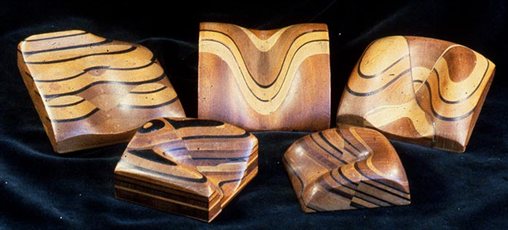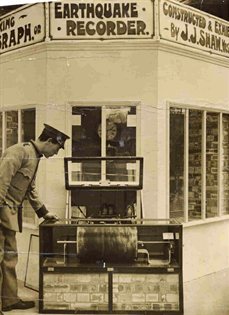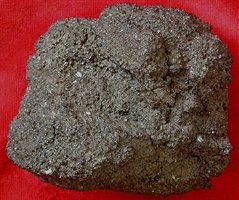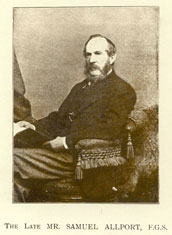In addition to the many important palaeontological, mineralogical and archive collections, the Lapworth Museum contains many other historically important collections.
The Sopwith Models
Thomas Sopwith FRS FGS (1803-1879) was born in Newcastle-upon-Tyne, the son of a cabinetmaker. Originally following his father's trade, he became involved in practical aspects of the geology of the Newcastle coalfield and the lead mines of the Northern Pennines. In terms of the geological structure these mining areas were relatively simple, but a thorough understanding of the geometry of the beds was essential when estimating coal reserves and the extent of coal seams or mineral lodes, which were affected by faulting.
Miners often struggled to predict the structural geology in three-dimensions, but by 1833 Sopwith developed a method using isometric projections to aid this process. In 1838 he began working on a series of three-dimensional wooden models of geological structures, using his original skills as a cabinetmaker. In 1841 he issued a set of twelve models designed to help geologists, or engineers, understand geological structures they might encounter in mines. Sopwith re-issued the models as a set of six in 1875, and in both sets the individual layers of strata are depicted using different types and colours of wood.

The Lapworth Museum has various examples of the different sets of models, which were often used in universities and colleges as teaching aids for map work and structural geology.
Shaw Seismograph
 John Johnston Shaw (1873-1948) was born in Gornal, in the Black Country, and was apprenticed to a number of engineering companies but, following his marriage in 1900 went into the family pawn-broking business in West Bromwich. Shaw became interested in seismology (the study of earthquakes) after meeting John Milne the retired Professor of Geology in Tokyo. The two became friends and began designing seismographs, culminating in the Milne-Shaw Seismograph of 1913 (the year of Milne's death), which was to become the international standard. The instruments, which detected horizontal ground motion due to earthquakes, were assembled by Shaw and his assistant in Shaw's greenhouse.
John Johnston Shaw (1873-1948) was born in Gornal, in the Black Country, and was apprenticed to a number of engineering companies but, following his marriage in 1900 went into the family pawn-broking business in West Bromwich. Shaw became interested in seismology (the study of earthquakes) after meeting John Milne the retired Professor of Geology in Tokyo. The two became friends and began designing seismographs, culminating in the Milne-Shaw Seismograph of 1913 (the year of Milne's death), which was to become the international standard. The instruments, which detected horizontal ground motion due to earthquakes, were assembled by Shaw and his assistant in Shaw's greenhouse.
Shaw's own home was used as a seismological observatory, and he became a well-known authority, providing early reports of distant earthquakes, and broadcasting a series about seismology in the early days of BBC radio.
The Lapworth Museum has Shaw's original seismograph, and a large archive relating to him, which includes numerous photographs of the instruments, and many of his seismograms, the actual printed records of the earthquakes recorded on his machine.
Priestley Collection
The Lapworth Museum has a small collection of items presented by the geologist and Antarctic explorer, Sir Raymond Priestley (1886-1974). Priestley accompanied Sir Ernest Shackleton on the Nimrod Antarctic Expedition of 1907-1909 and also served as geologist on Captain Scott's final, ill-fated expedition. He later became Vice-Chancellor of the University of Birmingham. Priestley gave a small number of Antarctic specimens to the museum including items collected during Scott's last expedition.
 Another interesting specimen presented by Priestley is the earliest collected specimen within the museum. It was collected in 1577 during the voyages of Sir Martin Frobisher (1535-1594), one of the earliest maritime explorers, who searched for the Northwest Passage in order to gain quicker access to the riches of the Orient. Frobisher's first voyage reached Baffin Island in Canada, and on his return there were tales of "black earth rich in gold". He returned to the area in 1577 and again during a later voyage, to bring back this ore. On his return, the ore was deposited in Dartford, Kent, but proved to be worthless, gold-free amphibolite and many of Frobisher's backers became bankrupt. Frobisher managed to remain in favour with Queen Elizabeth I and was knighted in 1588 in recognition of his heroic role during the defeat of the Spanish Armada. The specimen donated by Priestley is a piece of Frobisher's "black earth".
Another interesting specimen presented by Priestley is the earliest collected specimen within the museum. It was collected in 1577 during the voyages of Sir Martin Frobisher (1535-1594), one of the earliest maritime explorers, who searched for the Northwest Passage in order to gain quicker access to the riches of the Orient. Frobisher's first voyage reached Baffin Island in Canada, and on his return there were tales of "black earth rich in gold". He returned to the area in 1577 and again during a later voyage, to bring back this ore. On his return, the ore was deposited in Dartford, Kent, but proved to be worthless, gold-free amphibolite and many of Frobisher's backers became bankrupt. Frobisher managed to remain in favour with Queen Elizabeth I and was knighted in 1588 in recognition of his heroic role during the defeat of the Spanish Armada. The specimen donated by Priestley is a piece of Frobisher's "black earth".
Allport Collection
 Samuel Allport (1816-1897) was the first librarian at Mason College (the forerunner of The University of Birmingham) and also the first curator of the geology museum.
Samuel Allport (1816-1897) was the first librarian at Mason College (the forerunner of The University of Birmingham) and also the first curator of the geology museum.
He was an early pioneer of petrological microscopy and built up an extensive geological collection. From 1881 he regularly presented material to the Mason College museum including minerals, polished Devonian corals and, particularly, rock specimens and numerous examples of early thin sections.